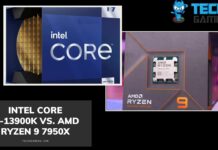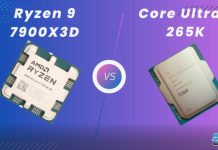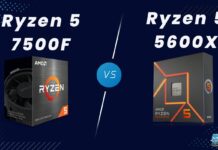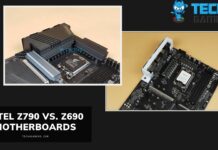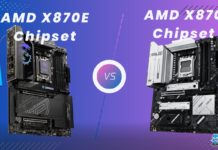The Ryzen 5 7600 is the basic processor of AMD’s latest Ryzen 7000 series, while the Core i5-13400 is a primary processor of Intel’s latest 13th generation. In Core i5-13400 vs Ryzen 5 7600, we shall meticulously examine the features and capabilities of these two processors.
Key Takeaways
- According to our tests, the gaming performance of the Ryzen 5 7600 is about 13.2% better than the Core i5-13400.
- At 1080p, I observed that the Core i5-13400 presents 20.3% more power efficiency and 35.8% more thermal efficiency than the Ryzen 5 7600.
- There is only an $8 difference in the launch MSRPs of the Ryzen 5 7600 ($229) and the Core i5-13400 ($221).
Comparison Table
| Feature | AMD Ryzen 5 7600 | Intel Core i5-13400 |
|---|---|---|
| Former Codename | Raphael | Raptor Lake |
| No. of Cores | Total: 6 | Performance Cores: 4 Efficiency Cores: 6 Total Cores: 10 |
| No. of Threads | 12 | 16 |
| Base Clock | 3.80 GHz | P-core base: 2.80 GHz E-core base: 1.80 GHz |
| Boost Clock | Max Turbo: Up to 5.1 GHz | P-core boost: 4.60 GHz E-core boost: 3.30 GHz Max Turbo: Up to 4.60 GHz |
| Unlocked For Overclocking | Yes | No |
| Integrated Graphics | AMD Radeon Graphics | Intel UHD Graphics 730 |
| Memory Support | DDR5 only | DDR4 and DDR5 |
| TDP | 65 watts | Base Power: 65 W Turbo Power: 154 W |
| Max Temperature | Up to 95°C | Up to 100°C |
| Thermal Solution | AMD Wraith Stealth | PCG 2020C |
| PCI Express Version | 5.0 | 5.0 and 4.0 |
| Launch Date | 1/14/2023 | Q1'2023 |
| Launch Price | $229 | $221.00 |
Architectural Difference
- Architecture: The Core i5-13400 employs Intel’s advanced hybrid Raptor Lake-S architecture, while the Ryzen 5 7600 integrates AMD’s cutting-edge Zen 4 architecture.
- Process Node: Intel simulates its Core i5-13400 using its 10nm fabrication node. In contrast, the Ryzen 5 7600 is forged on 5nm FinFET process at TSMC.
- CPU Socket: The Ryzen 5 7600 came with AMD’s inaugural LGA socket, the AM5 (LGA 1718), while the Intel Core i5-13400 adopts the FCLGA 1700 socket.
- Clock Speed: The Ryzen 5 7600 has a 35.7% higher base clock than the performance cores of the Core i5-13400, and regarding the boost clock, the Ryzen 5 7600 again takes a lead of about 10.9%.
- CPU Memory: Coming to memory specs, The Core i5-13400 boasts compatibility with DDR4 at a speed of 3200 MT/s, whereas the Ryzen 5 7600 does not support DDR4. Additionally, the DDR5 memory speed of the Ryzen 5 7600 is about 8.3% higher than that of its rival.
- Integrated Graphics: The Ryzen 5 7600 has a dual-core AMD Radeon Graphics iGPU with a turbo clock of 2200 MHz. In contrast, the Core i5-13400 features a dual-core Intel UHD Graphics 730 iGPU with a max clock of 1.55 GHz.
Gaming Benchmarks – 1080p
After reviewing the technical details of the Core i5-13400 and Ryzen 5 7600, let’s now analyze the gaming performance of the two processors. We will discuss their performance in eight demanding games we played at 1080p resolution. The system we used for playing games had the following specifications.
Gaming Rig
- OS – Windows 11
- RAM – Teamgroup T-Force Xtreem 48GB DDR5-8200 CL38
- CPU Cooler – Cooler Master MasterLiquid Lite ML240L RGB
- Graphics Card – GIGABYTE RTX 4090 Gaming OC 24G
- SSD – XPG Gammix S70 Blade 2TB NVMe
- Power Supply – ENERMAX REVOLUTION D.F. X 1050W
- GPU –GIGABYTE RTX 4090 Gaming OC 24G
Red Dead Redemption 2

- In our Red Dead Redemption 2 session, the average rendition by the Ryzen 5 7600 was 7 FPS or 4.5% greater than the Core i5-13400.
- The Core i5-13400 produced an average of 147 FPS at its best, while the Ryzen 5 7600 provided a flawless average of 154 FPS.
- During our gameplay, the Core i5-13400 ran at a lower power of 45 W, whereas the Ryzen 5 7600 ran at 62 W.
- Regarding the CPU gaming temperature, the Ryzen 5 7600 was running at a higher temperature of 71°C, while the Core i5-13400 ran at as low a temperature as 46°C.
- Moving to a Low 1% frame rate, we observed that the Ryzen 5 7600 delivered 105 FPS, while the Core i5-13400 could only muster up 97 FPS.
COD: Modern Warfare 2
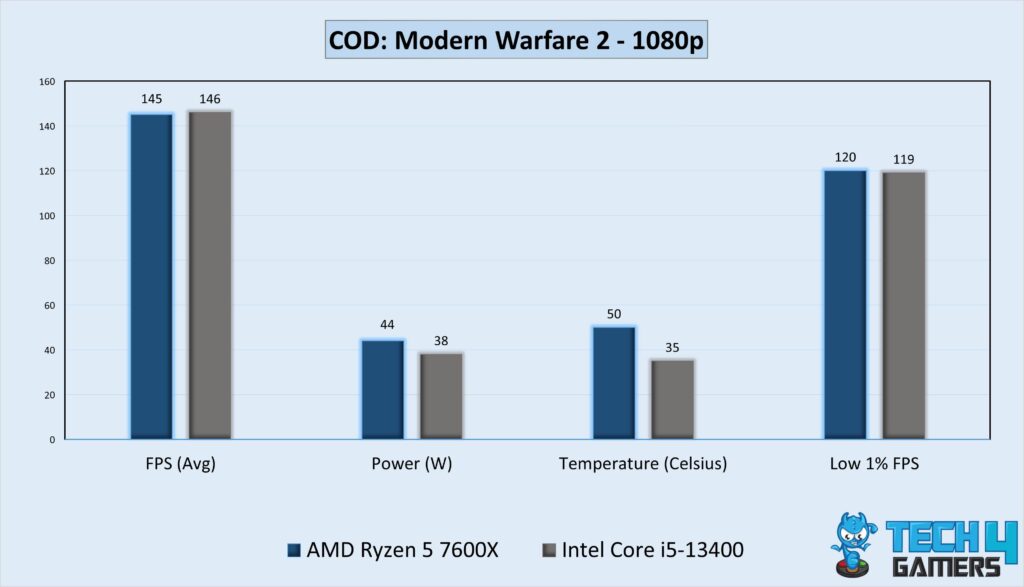
- On average, the Core i5-13400 rendered 2 only one FPS smoother than the Ryzen 5 7600 in our gameplay of Call Of Duty: Modern Warfare.
- At its finest, the Core i5-13400 delivered an average frame rate of 146 FPS, while the Ryzen 5 7600 delivered an average of 145 FPS.
- Per our testing, the Ryzen 5 7600 operated at 44 W, and the Core i5-13400 ran at a lower power of 38 W.
- We observed that the Core i5-13400 operated at a low temperature of 35°C, while the Ryzen 5 7600 ran at a higher temperature of 50°C in this game.
- Considering the Low 1% performance, the Ryzen 5 7600 produced 120 FPS, and the Core i5-13400 provided 119 FPS.
Cyberpunk 2077
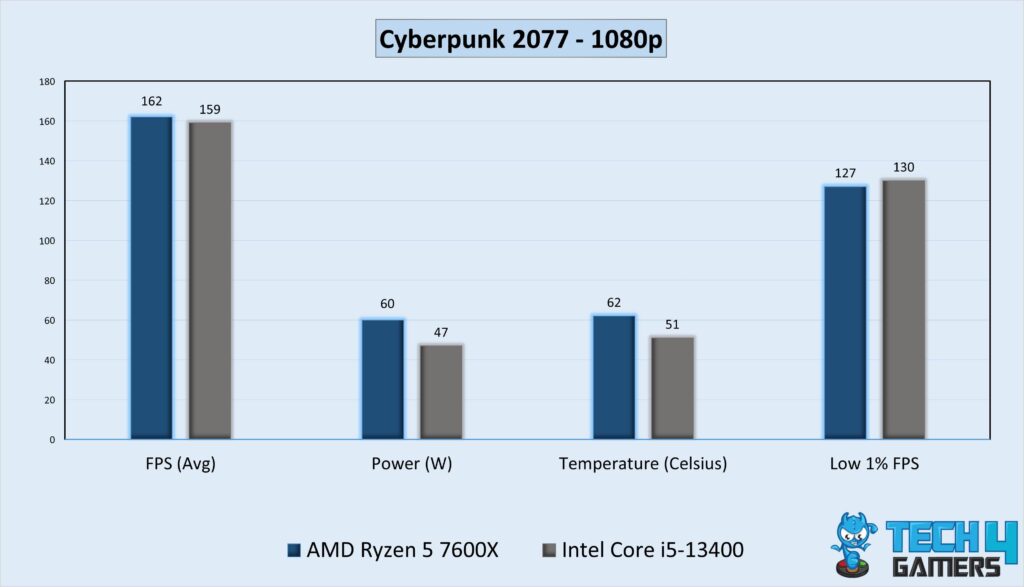
- While testing Cyberpunk 2077 in our benchmarks, the average rendition by the Ryzen 5 7600 was 3 FPS or 1.9% greater.
- The Ryzen 5 7600 produced an average frame rate of 162 FPS, while the Core i5-13400 generated 159 FPS.
- The Ryzen 5 7600 employed 60 W of electricity during our Cyberpunk 2077 gameplay, in contrast to the Core i5-13400’s consumption of 47 W.
- While the Ryzen 5 7600 ran at a greater temperature of 62°C, the Core i5-13400 ran at a lower temperature of 51°C.
- At its low 1% performance, the Core i5-13400 provided us with 130 FPS, and the Ryzen 5 7600 produced 127 FPS.
League Of Legends
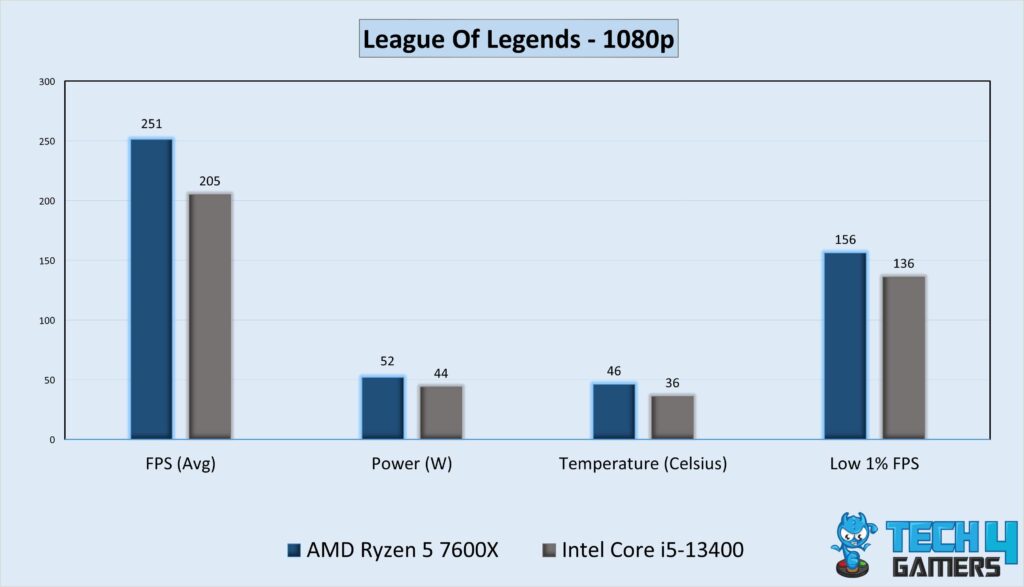
- In our League Of Legends gaming session, the Ryzen 5 7600 produced an average performance of 46 FPS higher or 22.4% better than the Core i5-13400.
- During this game, the Core i5-13400 generated 205 FPS on average, compared to 251 FPS from the Ryzen 5 7600.
- Moving to our power consumption test, the Ryzen 5 7600 consumed 52 W of electricity in this game, while the Core i5-13400’s power consumption was 44 W.
- Regarding gaming temperature, we noticed that the Core i5-13400 ran at 36°C, whereas the Ryzen 5 7600 ran at 46°C.
- The Ryzen 5 7600 generated 156 FPS at a low 1% performance, while the Core i5-13400 produced 136 FPS in League Of Legends.
Lost Ark
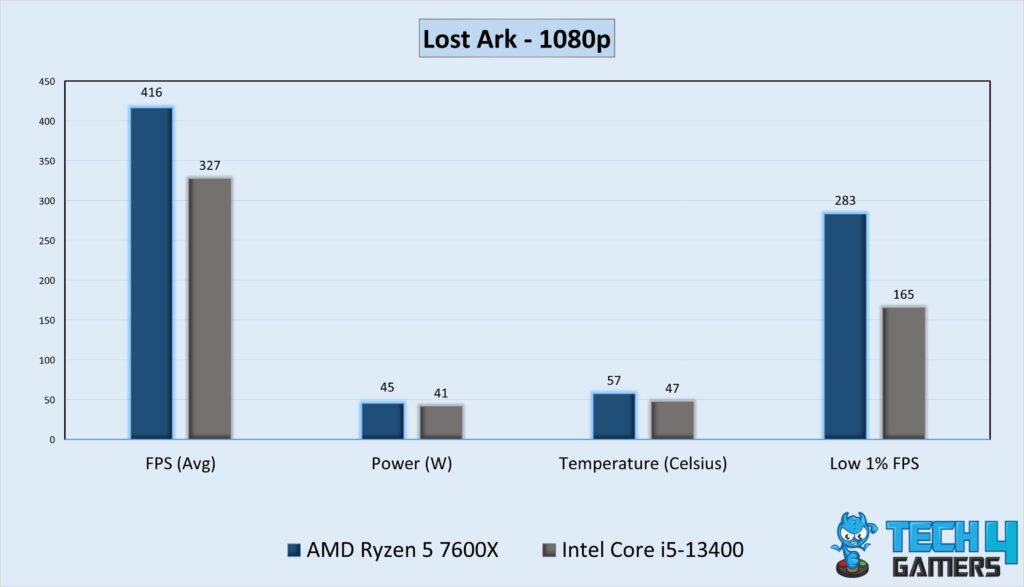
- The Ryzen 5 7600 outperformed the Core i5-13400 by an average of 89 FPS, or 27.2%, in our testing of Lost Ark.
- While playing the game, the average frame rate achieved by the Core i5-13400 was 327 FPS, while the average frame rate achieved by the Ryzen 5 7600 was 416 FPS.
- Compared to the Core i5-13400’s 41 W power usage, the Ryzen 5 7600 used 45 W in Lost Ark.
- When we tested the gaming temperatures, the Core i5-13400 ran at 47°C, compared to the Ryzen 5 7600’s operating temperature of 57°C.
- In Lost Ark, the Ryzen 5 7600 produced 283 FPS at a low 1% performance compared to the Core i5-13400’s 165 FPS.
Overwatch 2
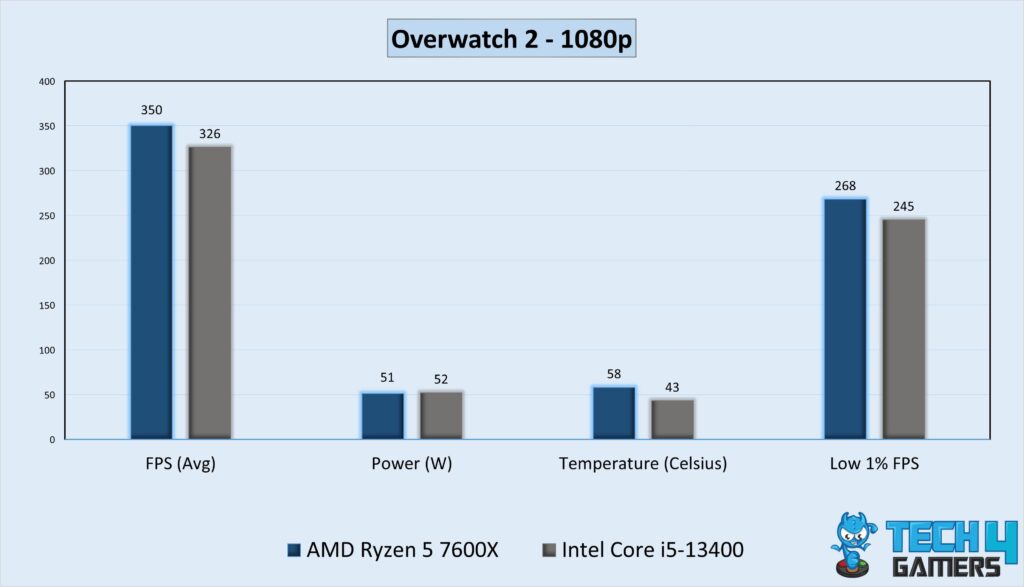
- In our Overwatch 2 session, the Ryzen 5 7600 outscored the Core i5-13400 on average by 24 frames per second or 7.4%.
- While playing the game, the Core i5-13400 managed an average frame rate of 326 FPS, while the Ryzen 5 7600 managed a 350 FPS average.
- Coming to our power consumption stats, the Ryzen 5 7600 consumed 51 W of electricity, while the Core i5-13400 ran at a higher power of 52 W in Overwatch 2.
- In this game, we noted that the operating temperatures of the Core i5-13400 and Ryzen 5 7600 were 43°C and 58°C, respectively.
- During our gameplay, the low 1% performance of the Ryzen 5 7600 was at 268 FPS, while that of the Core i5-13400 was at 245 FPS.
PUBG
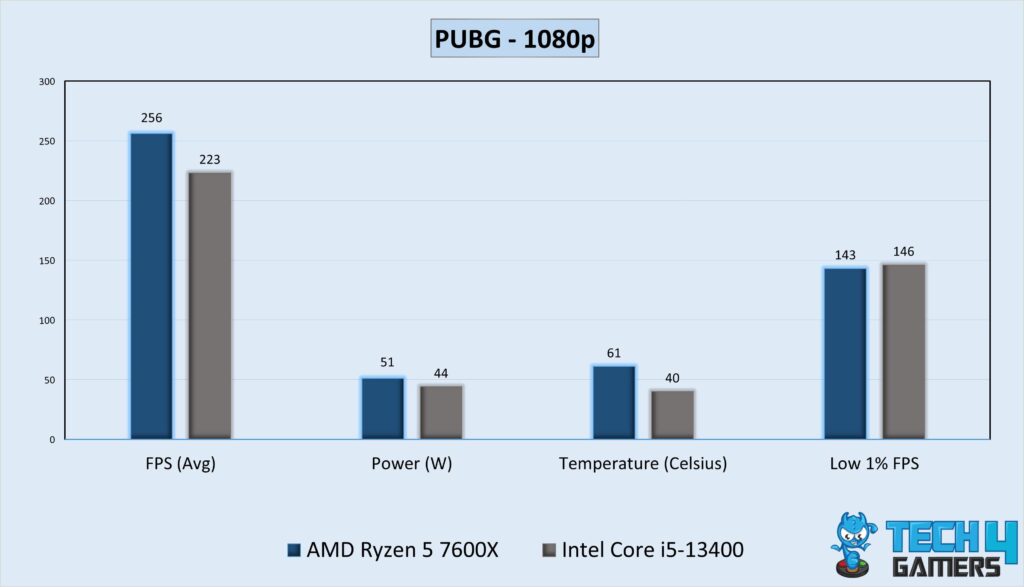
- The average performance of the Ryzen 5 7600 was 33 FPS or 14.8% better than the Core i5-13400 in PUBG.
- During our gameplay, the Ryzen 5 7600 managed an average frame rate of 256 FPS, while the Core i5-13400 delivered a 223 FPS average.
- The Core i5-13400 ran at a power of 44 W, whereas the Ryzen 5 7600 used 51 W of electricity.
- At 1080p resolution, the Core i5-13400’s running temperature of 40°C was stunning. The Ryzen 5 7600 operated at 61°C in the same conditions.
- Regarding our test of low 1% performance, the Core i5-13400 produced 146 FPS, and the Ryzen 5 7600 managed 143 FPS.
Spider-Man Remastered
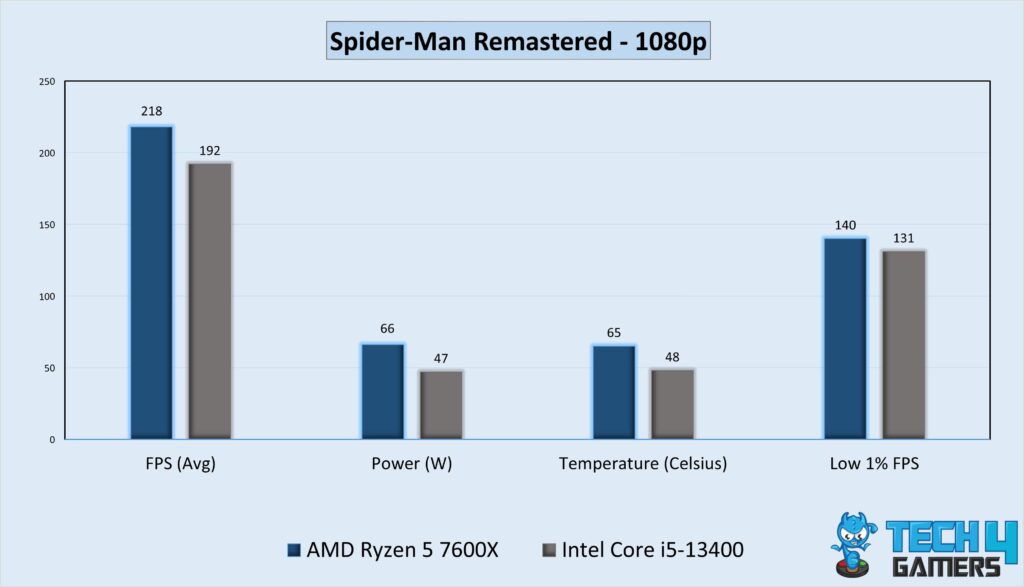
- When we played Spider-Man Remastered, the Ryzen 5 7600 yielded 26 FPS or 13.5% better performance than the Core i5-13400.
- The Core i5-13400 could only muster up an average of 192 FPS, while the Ryzen 5 7600 managed to furnish an average of 218 FPS.
- During our gameplay, the Core i5-13400 ran at a lower temperature of 48°C, compared to the Ryzen 5 7600’s higher 65°C operating temperature.
- During our power usage test, the power consumption of the Ryzen 5 7600 was 66 W during Spider-Man Remastered, while the Core i5-13400 performed at 47 W.
- Concerning the low 1% performance, the Core i5-13400 mustered up 131 FPS, and the Ryzen 5 7600 provided 140 FPS.
Overall Performance Analysis

According to our gaming benchmarks, the overall gaming performance of the Ryzen 5 7600 is 13.2% better than the Core i5-13400 at 1080p resolution. In the games mentioned above, the Core i5-13400 delivered us an average frame rate of 215.6 FPS, while the Ryzen 5 7600 rendered a brilliant average of 244 FPS.
In terms of low 1% performance, the Ryzen 5 7600 outperformed the Core i5-13400 by 14.8%. The Ryzen 5 7600 managed an average of 167.8 FPS at its low 1%, while the Core i5-13400 could only provide us 146.1 FPS at its low 1% performance.
Power Consumption
Reminder: The default TDP for the Ryzen 5 7600 is 65 watts. In contrast, the Core i5-13400 is configured with a base power of 65 watts and a max turbo power of 154 watts.
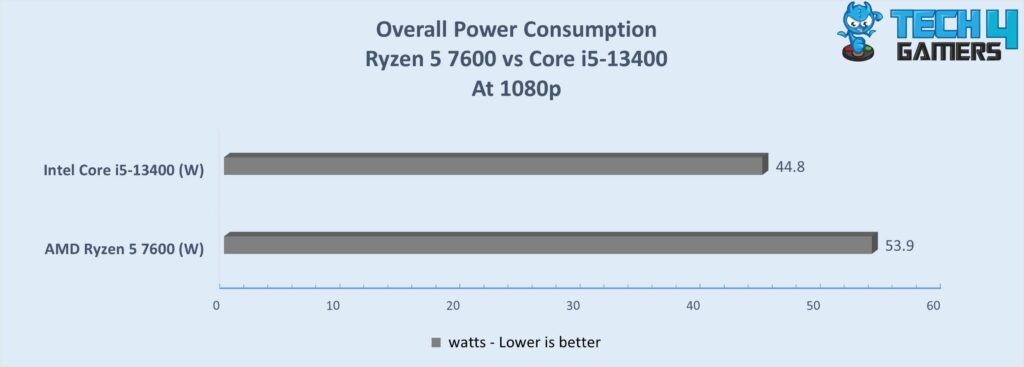
According to the power utilization tests we carried out throughout the games we played, the Ryzen 5 7600 ran at an average power of 53.9 watts, while the Core i5-13400 executed the same games at 44.8 watts. Thus, the Core i5-13400 is about 20.3% more power efficient than the Ryzen 5 7600.
Gaming Temperature
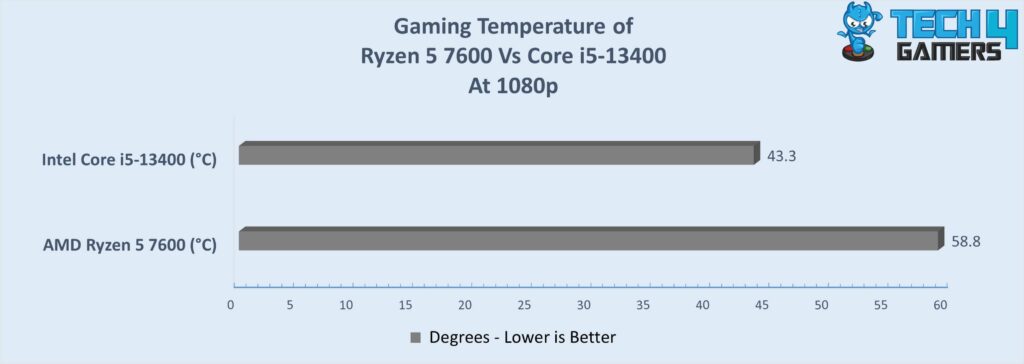
Regarding the CPU gaming temperature, the Core i5-13400 operated at an average temperature of 43.3°C in our gaming session, whereas the Ryzen 5 7600 operated at an average of 58.8°C. Thus, the Core i5-13400 is 35.8% thermally more efficient than the Ryzen 5 7600 based on our measurements. To overcome heating issues, read How To Lower CPU Temperature?
Price And Availability
After a detailed review of the performance and specifications, let’s discuss the cost and availability of the two processors. AMD launched the Ryzen 5 7600 for $229, and Intel launched the Core i5-13400 with an MSRP of $221.
The launch MSRPs of these processors are almost the same, and the trend in their current prices is also the same. Both of the CPUs are currently available in the market for around $200.
Concerning availability, these processors are available in most of the markets. You can also order them from the official online shops of Intel, AMD, and other platforms, including NewEgg and Amazon.
Which One Do We Recommend?
After the in-depth analysis of the Core i5-13400 vs Ryzen 5 7600, it’s time to choose between the two processors.
If you want the best gaming experience, we recommend the Ryzen 5 7600 for its 13% better gaming performance than the rival. But the Ryzen 5 7600 has a higher running cost due to more power consumption. So, if your monthly spending is limited, we recommend the Core i5-13400 for its about 20% greater power efficiency.
Pros And Cons
| Intel Core i5-13400 | AMD Ryzen 5 7600 | ||
|---|---|---|---|
| Pros | Cons | Pros | Cons |
| Low price | Does not support high data visualization technology | Attractive price | Lesser cores than the rival Intel processors |
| High thermal efficiency | It's not unlocked for overclocking | Good gaming performance in lower price | Consumes more power |
| Greater power efficiency | High clock frequencies | Attains higher temperature in gaming | |
More From Core i5-13400
More From Ryzen 5 7600
Thank you! Please share your positive feedback. 🔋
How could we improve this post? Please Help us. 😔
[Comparisons Expert]
Abdemanaf is a skilled creative writer who has been honing his craft since 2011. While initially working in different fields, he found a passion for technology and has been exploring the tech world since early 2015. Over the years, he has developed an in-depth knowledge of the latest tech trends and product offerings by various companies.
Abdemanaf’s writing reflects his analytical mindset and ability to think critically. He has a knack for breaking down complex technical information into easily digestible pieces, making his articles engaging and accessible to readers from all backgrounds. In February 2022, he joined Tech4Gamers as a blog and product comparison writer, where he has been able to hone his skills further.
As a writer, Abdemanaf is dedicated to staying up-to-date with the latest technological advancements and trends, enabling him to provide readers with the most relevant and accurate information. He is always eager to learn more and is constantly seeking new challenges to improve his skills.
Get In Touch: manaf@tech4gamers.com


 Threads
Threads